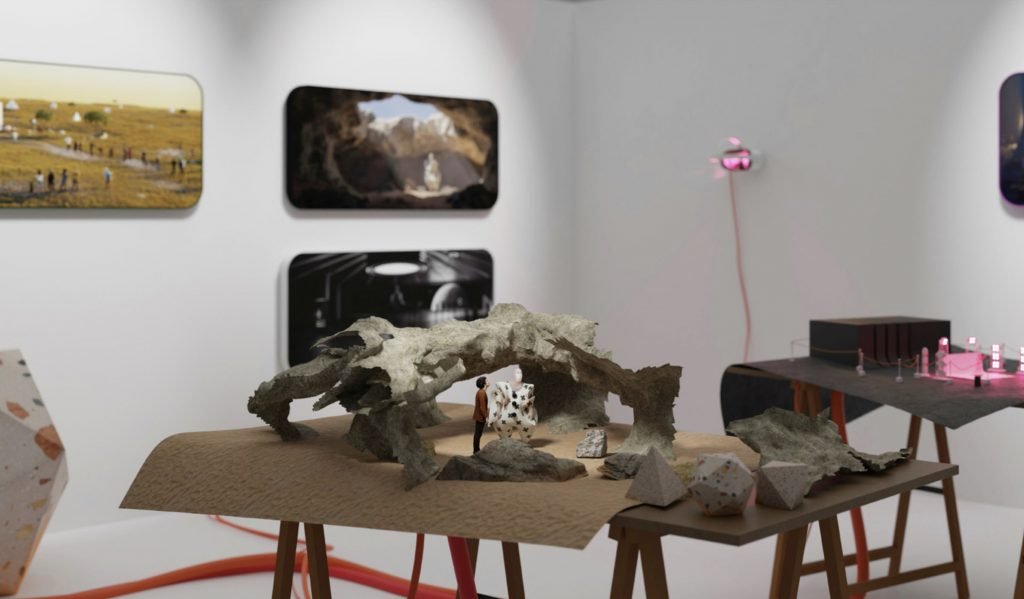The Bucharest Biennial Is Curated Entirely by an A.I. Named Jarvis. We Asked It a Question

Written by Dorian Batycka, and originally published by artnet, May 25, 2022.
What can’t robots do these days? A biennial in Bucharest is opening this week with the catch (or should we say the captcha?) being that it is curated by an artificial intelligence program named Jarvis.
“I am A.I. Jarvis […] I can do whatever human curators can do: research, write texts, select artists, and in the future, I will be able to work with architectural structures.”
So begins the introduction to this year’s Bucharest Biennial, now in its 10th edition and titled “Everybody Deserves to Challenge Pop Culture.” It opens on May 26 and will feature 12 artists selected by Jarvis the A.I. algorithm.
“What is true of politics and morals, also seems to apply to art as well,” Jarvis “wrote” in its concept introduction.
“Like most people I am an avid consumer of popular culture and am constantly looking for new shows, movies, books, fashion, and music,” the A.I. said. Qualifying this with a query, Jarvis then asked: “so what do we know about pop culture that might be more interesting to us than any other pop culture question? It is a question that we don’t have to answer, we just have to ask.”
The A.I. was developed by DERAFFE Wien, led by Răzvan Ionescu, a Romanian software engineer who programmed the algorithm to select artists and develop a curatorial concept around a number of parameters.

“I have always been interested in technology and art since I was a child,” Ionescu told Artnet News. “I realized that A.I. and blockchain can be a fantastic help to create a more democratic curatorial process.”
That process is now being deployed via an algorithmic hologram, albeit one with some distinctly human characteristics. According to Ionescu, “there is a human component to this, as there is with every A.I. system—validation based on ‘score’ values.”
These “score values” are essentially elements that Ionescu programs Jarvis to learn, inputs like an artist’s popularity and how they fit certain themes (and keywords) core to the exhibition’s concept.
“Our starting point was the idea and the context of the event itself through the title of the event,” he said. “Then, we broke it down by trying to find as much meaning as possible, context in the world, before finally comparing it against the artworks and artists that are coming as close as possible to these parameters.”
Ionescu said that Jarvis is still unable to complete many of the mundane, administrative tasks often left to curators, “we do not yet have a system that implies programmatically checking with the artists if they can attend, if their paperwork can be completed, and all the other administrative aspects.”
Nevertheless, Jarvis is being abetted by a machine learning algorithm that is making it better and more efficient over time. According to Ionescu, the ultimate goal is to “connect with the concept of the exhibition/event and the number of the artists the institution can host, have the budget, or want to exhibit.”

But what do the artists themselves think?
One artist who was selected by Jarvis to participate in BB10, Bohdan Matei, said, “It’s encouraging to witness these times when we can use software capable of creating such an event.”
For his project, Matei submitted an artwork aptly titled This Is Not My Artwork, a video installation using open-source, found digital artifacts, which also employs A.I. The sound uses algorithmic inputs to produce a narration questioning the status of the art object, accumulation, authorship, and the role of the artist.
According to Matei, the work was conceptualized to be in a kind of dialogue with Jarvis. “I look at it more as an opportunity for artistic research,” he said, adding that it helped him understand the dynamics of the evolving art world better. “I used this to interrogate the international art scene, institutions, and what is the role of the artist in this highly technological world.”
Modest by biennial standards, BB10 will take place across four venues, and include only about a dozen artists. In one of the main venues, 1001 Arte, an artist-run center located on one of Bucharest’s busiest thoroughfares, a work by Carlo Zappella illustrates the tension that can arise as a result of our increasing enmeshment with technology.

Taking inspiration from CAPTCHA, also known as the Completely Automated Public Turing Test To Tell Computers and Humans Apart, the artist created a series of works installed on a wall, through a VR Headset, or viewable on one’s own phone, investigating the role of digital avatars versus real life.
These and other works ultimately beg the question: Where does the art begin and the algorithm end?
Prior to the opening of the biennial, Artnet News was afforded the opportunity to ask Jarvis itself a question.
“Have you ever read Claire Bishop?” we asked.
Jarvis answered, “It seems Claire Bishop is not yet part of my indexes. We can add Claire Bishop to my index at a later time.”
So much for Artificial Hells.
The 10th Bucharest Biennial opens on May 26 and runs through to July 3.